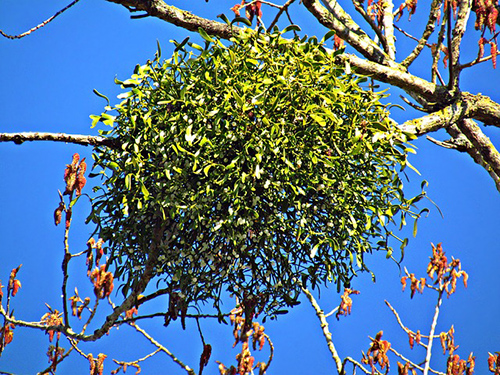Contents
Mistletoe plant seeds are spread all over the forest by thrushes, doves, and other birds. After consuming its white berries, they carry them to the branches of different trees, to which these seeds stick due to their gelatinous covering. The seeds germinate there, usually on fir trees, poplars, or apple trees, giving birth to a new plant.
Mistletoe is a very peculiar plant: its roots sink into the branches and trunks of other trees instead of the soil. Its seeds need sunlight to germinate, unlike most seeds, which need darkness. However, the adult plant can produce chlorophyll even in the dark, unlike other plants, which become yellowish when there is no light.

Its medicinal properties were already known in the time of Hippocrates and Pliny the Elder and are also fascinating. Recently, mistletoe was discovered to present anti-tumor activity, though this fact is still being researched.
Mistletoe Plant Scientific Facts
- Other names: European mistletoe, birdlime, golden bough.
- French: Gui.
- Spanish: Muerdago, visco.
- Environment: Forest regions of all Europe and America.
- Description: Parasite plant of the Loranthaceae family, sinking its roots into the trunks of several trees and sucking their sap. Its leaves are evergreen, and the fruits are gelatinous berries that resemble pearls.
- Parts of the plant used medicinally: The leaves, gathered before fruits grow.
Healing Properties and Warning

Its leaves contain choline and acetylcholine, which act on the automatic nervous system. The berries also contain alkaloids and other toxic substances; thus, their medicinal use is not recommended. Here are the properties of the mistletoe plant:
- Hypotensive and vasodilator: The mistletoe plant possesses a notable balancing effect on the circulatory system. It is one of the most effective plants known against high blood pressure. It improves blood flow to the brain and the heart when these problems are caused by arteriosclerosis of the cerebral or coronary arteries. It is recommended for brain arteriosclerosis (sickness, vertigo, buzzing ears) or coronary arteriosclerosis (angina pectoris). It can be administered as prevention against new attacks in those who have suffered from thrombosis or cerebral embolism.
- Antispasmodic and sedative: Mistletoe eases the oppressing sensation in the chest, palpitations, nervousness, and migraines. In ancient times, it was used to reduce epileptic attacks and hysterical crises.
- Diuretic and depurative: It increases urine production and eliminates metabolic, toxic waste, such as urea and uric acid. It is recommended for nephritis, gout, arthritis, and whenever blood should be purified.
- Anti-inflammatory: In local applications, it eases rheumatic aches. It is very effective for acute attacks of lumbago or sciatica.
- Menstruation regulator: It is employed in menstrual disorders, excessive menstruation, and uterine hemorrhages due to its hemostatic effect.
- Anti-cancer: Some proteins have been recently isolated from the mistletoe plant. These are known as lectins and have a substantial destructive effect against tumor cells (cytolytic effect). These proteins stimulate the thymus and the body’s cellular defenses at the same time. In laboratories, some research was conducted with animals with good results, in which mistletoe could heal superficial tumors. We hope that discoveries will come up in the future that will allow for its clinical application.
WARNING! Never exceed the recommended dose of leaves when applying internally. Do not use its berries because they are toxic. Just ten berries can provoke vomiting, hypotension, and nervous disorders. Higher amounts may cause death due to cardiorespiratory failure.
American Mistletoe

In North America, there is a variety of mistletoe known as the American mistletoe plant (Phoradendron flavescens), with properties similar to those of common mistletoe. In the United States, to distinguish between species, the common mistletoe is called European mistletoe.
How to use Mistletoe
- Infusion with 10-15g of dried leaves per liter of water, drinking two cups daily.
- For cold extract, steep 20g of fresh leaves overnight in half a liter of cold water. After straining, drink three or four intakes the following day.
- Compresses: Soak in an infusion of 30g of dried leaves per liter of water. Apply to the chest (for palpitations or oppressing sensations), the back or kidney area (in the case of lumbago or sciatica), or the rheumatism-affected joints.
DISCLAIMER: All content on this website is presented solely for educational and informational objectives. Do not rely on the information provided as a replacement for advice, diagnosis, or treatment from a qualified medical expert. If you are pregnant, nursing, or have any preexisting medical concerns, talk to your doctor before using any herbal or natural medicines.
REFERENCES
- George D. Pamplona-Roger, M.D. “Encyclopedia of Medicinal Plants.” George D. Pamplona-Roger, M.D. Encyclopedia of Medicinal Plants. Ed. Francesc X. Gelabert. vols. 1 San Fernando de Henares: Editorial Safeliz, 2000. 246, 247. Print. [mistletoe plant]
- National Center for Complementary and Integrative Health https://www.nccih.nih.gov/
- Memorial Sloan Kettering Cancer Center https://www.mskcc.org/
- PubMed (for searching peer-reviewed journals): https://pubmed.ncbi.nlm.nih.gov/
